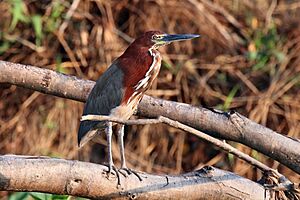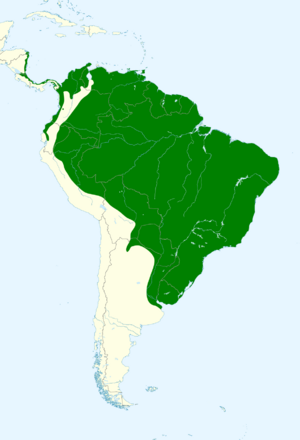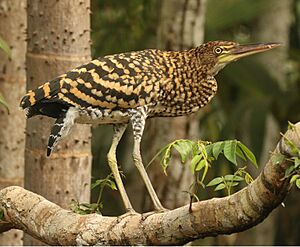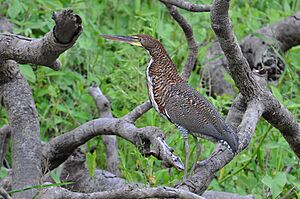Rufescent tiger heron facts for kids
Quick facts for kids Rufescent tiger heron |
|
|---|---|
 |
|
| in the Pantanal, Brazil | |
| Conservation status | |
| Scientific classification | |
| Genus: |
Tigrisoma
|
| Species: |
lineatum
|
 |
|
The rufescent tiger heron (Tigrisoma lineatum) is a cool bird that belongs to the heron family. You can find it living in wet areas, like swamps and marshes, all the way from Central America down through a lot of South America.
Contents
What's in a Name?
Scientists give every living thing a special two-part name. This helps everyone know exactly which animal they are talking about! The rufescent tiger heron's scientific name is Tigrisoma lineatum.
The first part, Tigrisoma, comes from old Greek words. Tigris means "tiger," and somā means "body." So, it's like "tiger-bodied"! The second part, lineatum, is from a Latin word meaning "marked with lines." This name fits because the bird has stripes and patterns, a bit like a tiger.
There are two slightly different types, or subspecies, of the rufescent tiger heron:
- T. l. lineatum: Found from Honduras south to parts of Bolivia and Brazil.
- T. l. marmoratum: Lives from southeast Bolivia to southern Brazil and northern Argentina.
How to Spot a Rufescent Tiger Heron
This heron is a medium-sized bird. It's about 26 to 30 inches (66 to 76 cm) long. It weighs between 630 and 980 grams (about 1.4 to 2.2 pounds). Both male and female birds look very similar.
Adult herons have a dark reddish-brown head, neck, and chest. They have a white stripe running down the middle of their front neck. The rest of their top feathers are brownish with tiny black wavy lines. Their belly is a light brown, and their sides have black and white stripes. Their tail is black with thin white stripes.
Their strong beak can be yellowish or dark. Their legs are a dull green. The skin around their eyes and their eyes themselves are bright yellow.
Young Herons Look Different
Young rufescent tiger herons look quite different from the adults. They are mostly rusty-buff (a yellowish-brown color) with thick black stripes. These stripes are very clear on their wings. Their throat, chest, and belly are white. It takes about five years for a young heron to get its full adult feathers.
Spotting Similar Birds
It's usually easy to tell an adult rufescent tiger heron apart from other "tiger herons." This is because its head and neck are reddish-brown, while others are mostly gray. But, young tiger herons can be much harder to tell apart!
Where They Live
You can find the rufescent tiger heron in wet places across Central and South America. They usually live in areas below 1,600 feet (500 meters). However, they have been seen as high as 5,200 feet (1,600 meters) in Colombia!
Daily Life and Habits
These herons are mostly active around dawn and dusk. They usually like to be by themselves.
What They Eat
Since they spend most of their time near water, these herons eat a lot of water creatures. Their diet includes fish, crabs, water beetles, and even dragonfly larvae. They also catch adult dragonflies and grasshoppers. They usually hunt alone. They stand hunched over in shallow water or wet forest areas, waiting quietly for their next meal.
Their Voice
The main call of the rufescent tiger heron is a low, paired hoot. They often make this sound at night. They also make a quick series of sharp "wok" sounds. These sounds get quieter and slower as they go on. Another call is a long hoot, which sounds like "ooooooo-ooh" and gets louder at the end.
Conservation
Scientists keep an eye on animal populations to make sure they are safe. Even though we don't know the exact number of rufescent tiger herons, they live in a very large area. Because of their wide range, the International Union for Conservation of Nature says this species is of "least concern." This means they are not currently in danger of disappearing.





